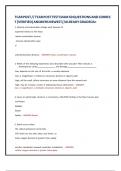TCAR POST // TCAR POST TEST EXAM 50 QUESTIONS AND CORREC
d d d d d d d d d d d
T {VERIFIED} ANSWERS NEWEST//ALREADY GRADEDA+
d d d d
1. Helmetsdanddautomobiled airbagsd workd becausedth
edypreventd blowsdtod thed head.
reducedaccelerationdinjuries
.dincreaseddecelerationdspee
d
.
addddecelerationddistance.d-dANSWER-reduced accelerationdinjuries.
2. Whichdofdthed followingdstatementsd bestddescribesdknifed wounds?dTheirdvelocitydis
dddd ,d thetemporaryd cavity ,d andddamage .
low;d dependsdondthed sizedofd thed knife;d isdusuallydextensive
low;disd insignificant;disdlimitedd tod structuresddirectlydindobject'sdpath
high;dwilldbedsmall;d affectsdstructuresdatdsomed distanced fromdthedwounddtract
high;d mayd bedmassive;d resultsd indwidespreaddtissueddestructiond -dANSWER-
dlow;d isd insignificant;d isd limitedtod structuresd directlyd ind object'sd path
4. Injuryd tod whichdbodyd structured isd commonlyd ad DELAYEDd findingd indthed blastd traumad pati
endt?Heart
Bladderd
Bowel
Spleend-dANSWER-Bowel
5. Shockdoccursdwhen
thedsodium-potassiumd pumpdfails.
ATPd levelsd ared lessd thand lacticd acidd levels.d ce
lldulardoxygend demandd isdgreaterdthandsupply
.
aerobicdmetabolismd exceedsd anaerobicd metabolism.d -d ANSWER-
cellulard oxygend demandd isd greaterd thansupply.
d
,6.
dddd shockd isd thedmostd commondtyped ofd shockd immediatelyd afterd traumaticd injury.Distr
ibutivedSepticdCardiogenicdHypovolemicd-dANSWER-Hypovolemic
7. Whichdfindingsd suggestd ad traumad patientd isd experiencingdcardiogenicd shock
?Bradycardia,dcyanosis,d andd elevateddmeand arteriald pressur
edHighdshockd index,d mottling,dandd hypotensiond Tac
hycardia,dflushing,danddwideneddpulsed pressure
Pallor,dcoursedbreathdsounds,danddhypertensiond-dANSWER-Highdshockdindex,dmottling,danddhypotension
8. Admultisystemdtraumadpatientdhasdbecomed progressivelydtachycardicdanddhypotensivedonedweekd a
ftderhospitald admission.dPulsed pressured isdwide.dThedmostd likelydexplanationd ford thisd findingd is
dehydration.
fatdembolismdsyndrome.
dsurgicaldsitedbleeding.ds
edpsis.d-dANSWER-sepsis.
9. Normalizingdad traumad patient'sd bodyd temperatured helpsd controld bleedingd becaused hypother
mdiaproducesdshiveringd anddmakesd plateletsdhyperactive.
causesdplateletddysfunctiondanddclottingdsystemd failure.d stidmulat
esdthedclottingdcascaded anddreducesd blooddpressure.
increasesd tissuedoxygend consumptiond andd coldddiuresis.d -dANSWER-
dcausesd plateletd dysfunctiond andclottingd systemd failure.
10. Whatdaredthed3dcomponentsdofdthed"traumadtriaddofddeat
hd"?Coagulopathy,d hypothermia,d anddacidosis
Hypothermia,dalkalosis,danddcoagulopath
dyAlkalosis,dhyperthermia,danddtissuedinju
rdy
Tissuedinjury,dhyperthermia,danddacidosisd -dANSWER-Coagulopathy,dhypothermia,danddacidosis
, 11. Compensatorydresponsesdtodhypovolemicdshockdinclu
ddevasoconstriction,dtachycardia,d andd oliguria.
immuned systemd activation,dwaterd retention,danddbradycardia
.tachycardia,d diuresis,d anddhypoglycemia.
fluiddshifts,d histamined release,d anddincreaseddurinedoutput.d -dANSWER-
dvasoconstriction,d tachycardia,d andoliguria.
12. Whatdfourd factorsd determined ad patient'sd cardiacdoutput
?Pulsed pressure,d afterload,d shockd index,d andd bloodd press
udred Heartd rate,d preload,dcontractility,d andd afterload
Preload,dmeandpressure,dheartd rate,danddcentraldvenousd pressure
Contractility,d systolicd pressure,d shockd index,d anddpulsed pressured -dANSWER-
dHeartd rate,d preload,contractility,d andd afterload
13. Traumad resuscitationd isd consideredd completed whend hemorrhaged isd controlled,dthed patientd hasd nor
mdalvitald signs,dand
bodyd temperatured hasdbeend stabilized.
dhemoglobind leveld isd greaterd thand8d g/
dL
.aerobicdmetabolismd isd reestablished.
thedGlasgowdComadScaledscoredexceedsd13.d-dANSWER-aerobicdmetabolismdisd reestablished.
14. Adpatientdwithdposteriord ribdfracturesd isdatdthedhighestd riskd fordconcomitantd fracturesdo
fdtdhesternum.
T-
spine.dcl
avicles.
d
ribsd1d andd2.d -dANSWER-T-spine.
15. Admotocrossd racerd hitd ad ditchd atd highd speed.d Thed rider'sd chestd wasd throwndagainstd thed handle
badrs.Whichd assessmentd findingd indicatesd thed patientd hasd ad flaild chest?




